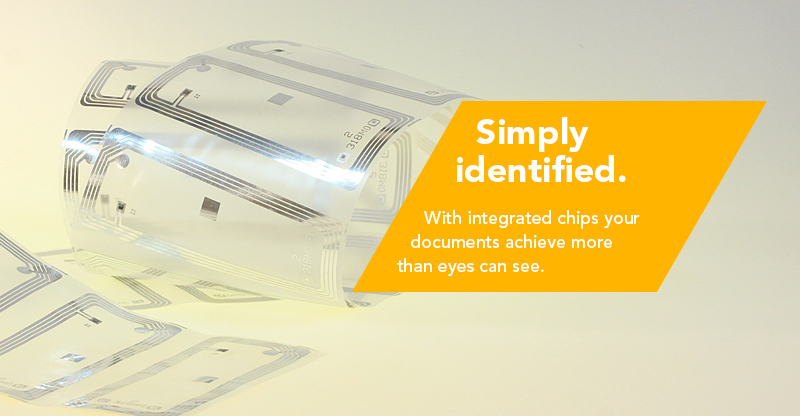DOCUMENTS WITH RFID-CHIP
- Integration of RFID-Chips into printed documents
- Allows transmission of information via wireless technology
- For identification, detection and localisation
- Regardless of weather or pollution
- Bulk reading
- No need of visual contact between reading device and RFID-Chip
- Combinable with additional security and logistical techniques
Invisible Signals.
Your documents do not only speak to the one who holds it in his hand. Who inspects or reads them. Because your documents can do more: Invisibly and imperceptibly, they send small signals that are received and understood by a suitable reader via RFID. What can you do with it? Endless possibilities. Recognise your customers already while visiting the exhibition stand or reaching the meeting rooms. Relieve your employees from consuming scanning tasks. Take parcels on the right track. Use the time and cost advantage due to bulk reading systems. Benefit from documents that say more than you see at first glance.
What does “RFID” mean?
The abbreviation RFID ("radio frequence identification") stands for a so-called transponder technology. Transponders are small communication devices that receive, reply, and, if necessary, forward incoming signals via radio. A transponder can be located in a fair pass, for example, and send out a small code. This code is assigned to the name of an exhibition visitor. A reader can receive and assign this code via RFID-Technology. In the same way can parcels be localised and clothing secured in the department store against theft.
Quick and easy: the way to your desired product.
beratung(at)koopmann.de
Phone +49 421 56905-0
With these special forms, the RFID-Chips are directly integrated into the paper. You can provide the documents with information such as name, address, etc. by PC and print them via laser printer. For delivery notes with RFID-Chips, for example, an automatic assignment to the appropriate parcel is possible.
Labels with embedded RFID-Chips offer a variety of possibilities. They allow fast sorting of goods in logistics and storage area, simple inventory or identification and management of luggage at the airport. They serve as anti-theft protection, price-labelling and storer of expiry date in the retail sector or video or library rental.





